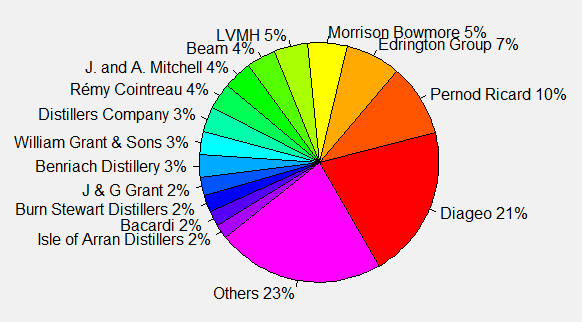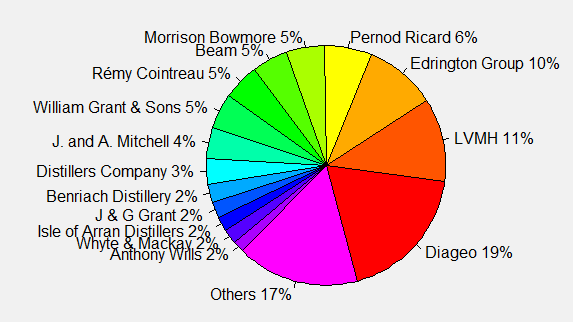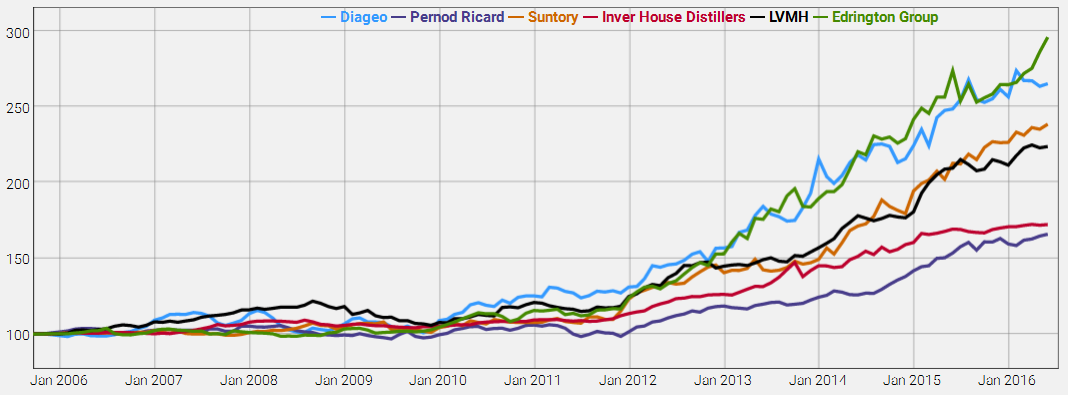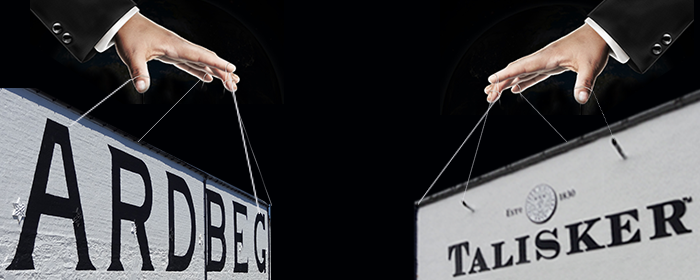It is time for the next step in the analysis of the secondary whisky market. Today, we take a closer look at those entities who actually own the distilleries that produce the bottles we drink and trade. Who are they? How much do they own?
Isn’t it a nice illusion? We sip at our whiskies and think about the old experienced craftsman that produced this spirit with all of his knowledge, experience and passion. We consider ourselves lucky since we managed to get our hands on one of those few bottles he was willing to sell to some stranger not wearing a kilt. But lets face the truth, the whisky business is not that romantic anymore. Most distilleries are owned by some other, bigger company and hence some of the most important decisions on their production strategy are part of a sophisticated business plan.
In this article we want to have a look at those companies behind the scenes. Whats their share of the secondary market we observe? How many distilleries do they own?
Please note: The following numbers, figures and graphs are all based on our whisky database which consists of the single malt whiskies that were traded on the auction platforms we track. Hence, this is an analysis of an (fairly large) extract of the secondary whisky market and NOT the primary whisky market or the whisky market in total.
Major Players
To start off we take a look at the current owners of the whisky distilleries. At the time of writing this article we find 134 scotch and 10 japanese distilleries in our database. For this article we tracked down the corresponding owners as of July 2016. We found 45 different entities where the biggest ones (in terms of number of owned distilleries) are listed below.
Diageo: 40 distilleries
Pernod Ricard: 16 distilleries
Suntory: 7 distilleries
Bacardi: 6 distilleries
Inver House Distillers: 6 distilleries
William Grant & Sons: 4 distilleries
Whyte & Mackay: 4 distilleries
Out of the 144 distilleries in our database, 28% are owned by Diageo. Second placed Pernod Ricard owns 11%. So almost 40% of the distilleries are owned by these two companies alone! If we restrict our attention to Scotland only, the five corporations Diageo, Pernod Ricard, Bacardi, Suntory and Louis Vuitton Moet Hennessy (LVMH) own 50% of the distilleries. So every second scotch distillery is owned by one of these multinational companies. Note that the other producers in our database all own three or less scotch or japanese whisky distilleries.
Who´s your Daddy?
As we do not want to list all of the 144 distilleries and their owners, at least we want to point out some of the most famous ones.
So what about Ardbeg? Month after month we find out that this distillerie´s bottlings belong to the most traded whiskies of them all. We guess the reason for this, beside the great whisky of course, is the great marketing strategy. Responsible for this is LVMH, who also own Glenmorangie and sell pretty much everything else that is expensive.
According to our observations the second most traded distillery is Macallan. Macallan is owned by the Edrington Group. So are Highland Park and Glenturret.
It is worth noticing that in the below market share analysis we list Morrison Bowmore, which owns Auchentoshan, Bowmore and Glen Garioch, separately from Suntory although it is technically owned (as far as we understand) by Suntory. Beam Suntory or Suntory, on the other hand, own distilleries like Laphroaig, Ardmore, Hakushu and Yamazaki.
And what about secondary whisky market legends like Brora, Port Ellen and Rosebank? They (or what is left of them) are all owned by Diageo. On the active site of Diageo´s distillery portfolio we find names like Auchroisk, Caol Ila, Clynelish, Lagavulin and Talisker, to name a few.
(Secondary-) Market Share
Since we now have a rough overview on which companies own which distilleries, we want to assess these companies´ share of the secondary market. For this purpose we have two possibilities which we will address both. First we want to find out how the 17.702 whiskies in our database distribute to these companies. So out of the 17.702 whiskies we have in our database, 21% were produced in a distillery that is now owned by Diageo. On the places follow Pernod Ricard (10%) and the Edrington Group (7%). Overall it seems like if we look at the secondary whisky market on a bottle basis the market seems a little bit more diversified than the sheer number of owned distilleries might would have suggested. Remember that technically Morrison Bowmore and Beam add up to 9% market share for Suntory, which would equal the third place in this ranking.
So out of the 17.702 whiskies we have in our database, 21% were produced in a distillery that is now owned by Diageo. On the places follow Pernod Ricard (10%) and the Edrington Group (7%). Overall it seems like if we look at the secondary whisky market on a bottle basis the market seems a little bit more diversified than the sheer number of owned distilleries might would have suggested. Remember that technically Morrison Bowmore and Beam add up to 9% market share for Suntory, which would equal the third place in this ranking.
The second possibility to measure these companies´ share on the market are the number of trades. By July 2016 we find 206.861 price observations in our database. So like we did above for the whiskies themselves, we have a look at how much of these trades belong to every companies´ distilleries. So what we see is that from this angle, the market is slightly less diversified than on a bottle basis. The biggest eight companies now share two-thirds of the trades, while they only accounted for 60% of the whiskies. A direct comparison between bottle- and trade-share is especially interesting for LVMH. While “only” 5% of the whiskies were produced in one of their distilleries (Ardbeg and Glenmorangie), 11% of the actually traded bottles come either from Ardbeg or Glenmorangie. Similar holds for the Edrington Group. On the other side, Diageo´s share on the trades (19%) is less than their share of the whiskies (21%).
So what we see is that from this angle, the market is slightly less diversified than on a bottle basis. The biggest eight companies now share two-thirds of the trades, while they only accounted for 60% of the whiskies. A direct comparison between bottle- and trade-share is especially interesting for LVMH. While “only” 5% of the whiskies were produced in one of their distilleries (Ardbeg and Glenmorangie), 11% of the actually traded bottles come either from Ardbeg or Glenmorangie. Similar holds for the Edrington Group. On the other side, Diageo´s share on the trades (19%) is less than their share of the whiskies (21%).
Price Development
With this ownership relations we found another partition of the market. And since we are Whiskystats, and we love to calculate price indices, it is only natural for us to compare these companies by the price evolution of the 100 most traded whiskies in their portfolios.
Note that for this purpose we do not consider any historic changes in ownership. So we see quite a difference in the price developments. Until February 2016, the 100 bottles from Diageo experienced the highest rise in value. In the subsequent four-month though, those bottles lost 3% in value. In the same time, the 100 single malt whiskies from the Edrington Group gained almost 11% in value. This makes the Edrington Group the top value gainer among the major single malt whisky producers today. In the midfield we see Suntory (Beam and Morrison Bowmore) and LVMH battling for the third place. More than 50 index points behind are Inver House Distillers and Pernod Ricard, which bottlings experienced the least gain in value among these big whisky companies.
So we see quite a difference in the price developments. Until February 2016, the 100 bottles from Diageo experienced the highest rise in value. In the subsequent four-month though, those bottles lost 3% in value. In the same time, the 100 single malt whiskies from the Edrington Group gained almost 11% in value. This makes the Edrington Group the top value gainer among the major single malt whisky producers today. In the midfield we see Suntory (Beam and Morrison Bowmore) and LVMH battling for the third place. More than 50 index points behind are Inver House Distillers and Pernod Ricard, which bottlings experienced the least gain in value among these big whisky companies.
Independent? Someone?
So are all distilleries under control of someone else? Well, not all of them. We find four distilleries in our database which can be called “independent” to our knowledge. These are three relative youngsters and one grandfather of the single malt producing industry. Abhainn Dearg, Wolfburn and Kilchoman were all founded in the 21st century. Compared to that, Springbank, which was founded back in 1828, has experienced (and survived) all of the ups and downs of the whisky business. We here want to state (but do not want to claim any connection or whatsoever) that the two out of these four independent distilleries for which we have enough price observation to calculate a Whiskystats index, do not perform very well in our distillery ranking. Springbank, with an index value of 135 points, takes place 101 out of 128 in this ranking. Kilchoman is even last with only around 80 points by July 2016, which makes it the only distillery in our database which bottles lost value since we started tracking them.
